
Dive into this downloadable article that offers five ways you can innovate at your institution to improve student success and efficiency in an area that you may have previously overlooked: the course schedule.
If you would like additional assistance in accessing this resource, please email our team at marketing@aais.com.
Dive into five ways you can innovate at your institution to improve student success and efficiency in an area that you may have previously overlooked: the course schedule.
Higher education is facing a multitude of challenges simultaneously. Many institutions are seeking to address declining enrollments and resources while facing increasing skepticism about the value of college from students, parents, the public, and policymakers, as highlighted by the Pew Research Center. These issues are challenging institutions to innovate in ways perhaps inconceivable a generation ago. This article offers five ways you can innovate at your institution to improve in an area that you may have previously overlooked: the course schedule.
If you think about it, the course schedule touches facilities, faculty, and students. Since the course schedule impacts the core of the academic institution, any positive changes, no matter how incremental, can have a substantial impact. Whether you attempt one or all five of these changes, remember that nearly any improvement in the course schedule can positively impact students, programs, and your institution.
Today, there are two million fewer students attending colleges and universities than in 2011, the peak enrollment over the past decade, according to the recent Forbes article, “College Enrollment Declines Again. It’s Down More Than Two Million Students In This Decade.” Additionally, the National Student Clearinghouse Research Center has shown enrollment has declined in every sector of higher education for the past four years. Since the Great Recession, the number of births has also declined, and demographic research by Nathan D. Grawe estimates that by 2030, the number of “traditional first-year students,” those aged 18 attending college for the first time, will decline by about another 9 percent. To offset the decline of “traditional students,” those aged 18-24, enrollment managers have sought to attract more “post-traditional students,” those aged 25 and older.
Recommended Resource: Demographics and the Demand for Higher Education by Nathan D. Grawe Webinar
As the economy has improved, Education Dive’s article, “Adult Learner Enrollment Keeps Sliding, New Data Shows,” highlights that post-traditional enrollment has also declined as fewer adult learners feel the need to skill-build at colleges and universities. Cognizant of the counter-cyclical nature of education and the economy, enrollment managers have increasingly relied on the growth of international students at their institutions to offset domestic declines in enrollment. More recently, however, even international enrollment has declined by 6 percent, as seen in Inside Higher Ed's article, “New International Student Enrollments Decline Again.”
Faced with the daunting challenge of chasing enrollment or constantly reaching out to prospective individuals who may or may not enter their college or university, enrollment managers are also engaging in retention strategies. Generally, enrollment managers seek to ensure that their institution offers the “right fit” for students.
“Fit” is a very important concept in higher education recruitment and retention. Each year, the College Board attracts millions of views through its BigFuture website, which is designed to help prospective students find “Your College Fit.” Similarly, NACAC, the National Association for College Admission Counseling, urges both parents and students to “look for a good fit” that aligns with their educational goals and preferred learning style. For some enrollment managers, the alignment between student goals and their education is so important that they have attempted to quantify this relationship through a “fit factor,” that they believe is closely aligned to student retention at their institution. From an enrollment management perspective, it makes a lot of sense to focus on ensuring the proper fit between student and college, especially in the face of declining enrollment overall.
However, once a student commits to an institution, there are precious few options available to an enrollment manager at your institution to improve student satisfaction or retention. One option is the course schedule. Ensuring that students have the courses they need is often something that registrars and enrollment managers can act upon to help students persist and graduate. In his book Strategic Enrollment Planning, Jim Hundrieser argues that “enrollment management professionals should ensure that courses are offered and available as promised,” and that “only within this framework can proper degree planning occur.”
Recommended Resource: Strategic Scheduling Evaluation
Ensuring that courses are offered as promised is among the most basic steps any college or university can undertake to support student retention. There is ample evidence that course availability is important to students. Among more than 170,000 four-year students, recent National Student Satisfaction and Priorities Report found that 91 percent of adult undergraduates reported the ability to register for classes with few conflicts as important. Despite the overwhelming importance placed by students on their ability to register for classes with few conflicts, only 53 percent were satisfied with their registration experience, which is a 36 percent performance gap, among the largest in the national survey of student satisfaction
(Performance Gap = Importance Percentage minus Satisfaction Percentage). To ensure that courses are offered as the course schedule promises, Ad Astra’s blog highlights “The Art and Science of Scheduling” with key focus areas for building the course schedule.
Recommended Resource: The Art and Science of Scheduling
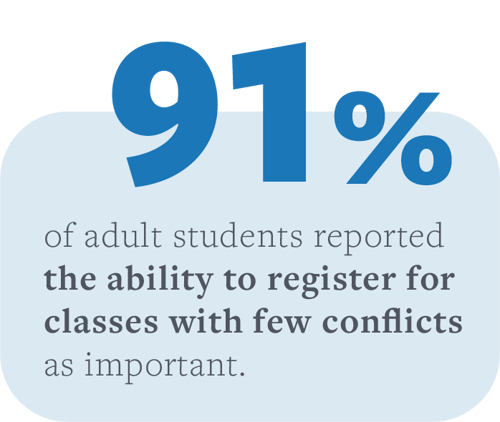
(Figure 1 Source: 2019 National Student Satisfaction and Priorities Report)
Ad Astra, a leading course scheduling and enrollment management organization, has found that effective course scheduling through managing the enrollment ratio can improve outcomes. The enrollment ratio refers to the overall rate of census date section enrollment divided by the section enrollment cap. Focusing on this metric can help ensure the proper number of seats are offered for each course to help students stay on plan. After reviewing the course schedules of more than 300 colleges and universities, Ad Astra found that institutions should strive to have an enrollment ratio for each class of about 85 percent (85 enrolled students for 100 seats).
Recommended Resource: Monitor: Through the Eyes of an Associate Provost

(Figure 2 Quartile Boxplot for Enrollment Ratio among Higher Education Scheduling Index (HESI) Institutions)
If students do not have the courses they need, they may be less satisfied with the “fit” at your institution and may take the courses they need online at another nearby college or university. Therefore, effectively managing your enrollment ratio can aid in student fit and help ensure there is ample capacity to help your students succeed. Furthermore, maintaining a healthy enrollment ratio has been shown to be positively associated with student retention. Although Ad Astra recommends an 85 percent enrollment ratio, less than 25 percent of institutions that we initially benchmark average that fill rate overall at their institution.
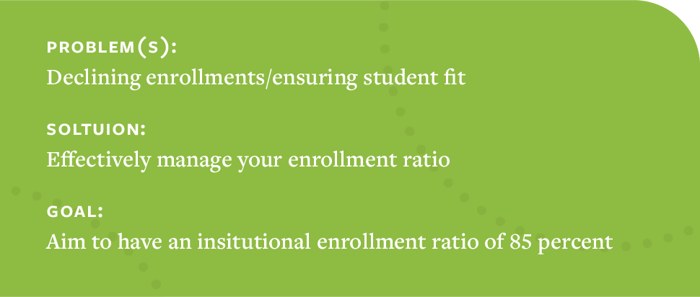
(Insert 1 - Effectively Manage Your Enrollment Ratio)
Ensuring course availability is an important first step in effective enrollment management that is largely within the control of your institution. However, focusing solely on accessibility may lead to some less than desirable results. Therefore, it is important to strike a balance between making seat availability at nearly any time, and the increasing resource constraints likely faced by your college or university. Balance in course offerings at your institution is important because if courses are overloaded (exceeding 95 percent of enrollment capacity at census date), students may be unable to get the courses they need, when they need them.
Figure 3 below illustrates the problem of overloaded course offerings. When there are too many students and not enough seats, students may leave your institution to take those courses elsewhere, or they may delay taking those courses, which can negatively impact their time-to-completion. When students are taking courses in a sequence, any delay may restrict on-time completion (e.g., the inability to take a pre-requisite will necessarily delay a subsequent requisite course). Beyond the challenges associated with student success, overloaded courses generally represent a loss of tuition revenue as institutions are unable to maximize student demand for course offerings. Research from Ad Astra has found that approximately 22 percent of all courses at a typical institution are overloaded.
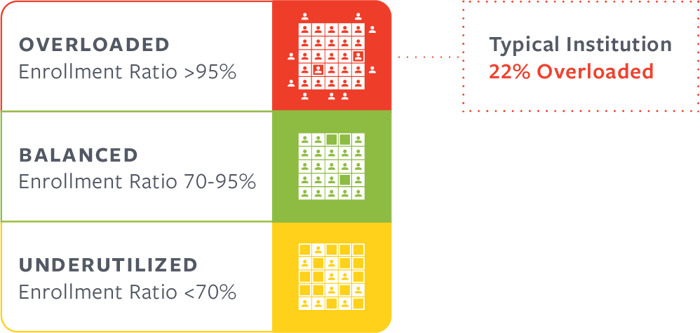
(Figure 3 - Overloaded Courses)
Conversely, if course offerings are underutilized (below 70 percent capacity at enrollment date), institutions may not be optimizing their scarce resources of facilities and faculty to meet student needs. If an institution offers a course that is in low demand, it often comes at the expense of offering another course that would better align with student needs.
At many institutions, the decision to offer courses is made by faculty and department chairs in consultation with administrators such as deans, registrars, and perhaps other enrollment management professionals. Generally, course scheduling decisions are neither arbitrary or capricious, but rather, based upon what was traditionally offered, and who is available to teach those courses at present. On the surface, this appears to be the most prudent approach, and in many instances, that may be the case. However, recall that over the past four years, enrollment has declined in every sector and there are now two million fewer students than there were in 2011. Declining enrollments materialize at the section level, and at many institutions, the decision to continue to do what was done last semester, or last year, may no longer be appropriate.
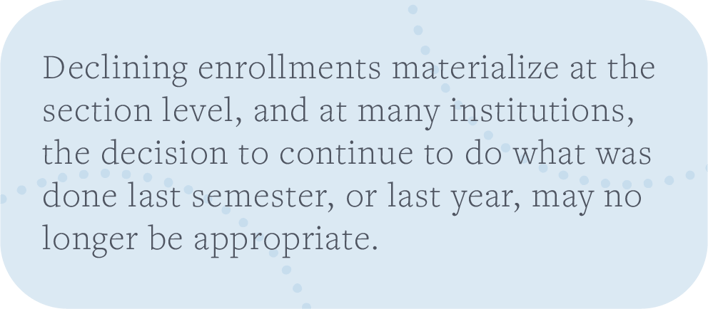
(Insert 2 - Balance Courses to Promote Student Success)
Recommended Resource: Progress on Student Progress
While underutilized courses may provide ample accessibility for students, they are generally inefficient from a room scheduling and faculty perspective, and massive underutilization may negatively influence student outcomes as well. If most students prefer, or, are only available to take courses in a compressed timeframe, offering the same courses repeatedly comes at the expense of other needed offerings. Similarly, if the schedule has a preponderance of only general education or a preponderance of only elective courses, those offerings come at the expense at what best aligns to student needs.
As Figure 4 below indicates, approximately 45 percent of all courses on a typical institution are underutilized (capacity below 70 percent). Consistent with the recent historical trend, as the total enrollment of higher education has declined, the percentage of underutilized course offerings has increased. Therefore, effectively managing course offerings can help promote course access, student success, and save your college or university money in the process.
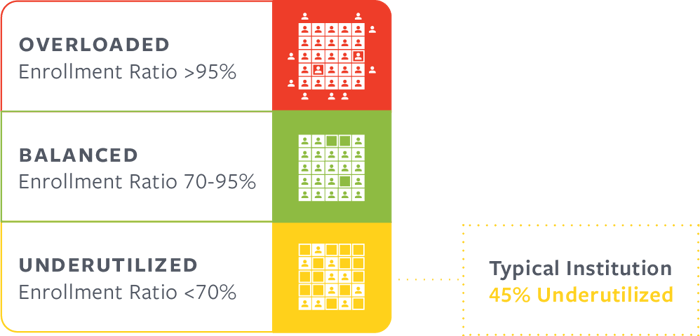
(Figure 4 – Underutilized Courses)
Institutions that do commit to better aligning course offerings can see some impressive results. Recently, Stephen F. Austin State University (TX) worked with Ad Astra to better align course offerings to student needs. By addressing overloaded course offerings and seeking to better align underutilized courses, Stephen F. Austin State University was able to hire 19 more full-time faculty members, generate an additional 3,000 student credit hours, and earn more than $1 million in new revenue after paying their new full-time faculty hires.
Recommended Resource: When Faculty Lines Pay for Themselves
When courses fall between an enrollment ratio of 70 to 95 percent, those courses are determined to be balanced. Balanced courses are well aligned to pedagogical and enrollment needs, which can help ensure faculty can provide the attention needed for greater student success while still providing an efficient use of faculty and facility space. As Figure 5 below indicates, only 33 percent of courses are balanced, leaving institutions tremendous opportunities for improvement.
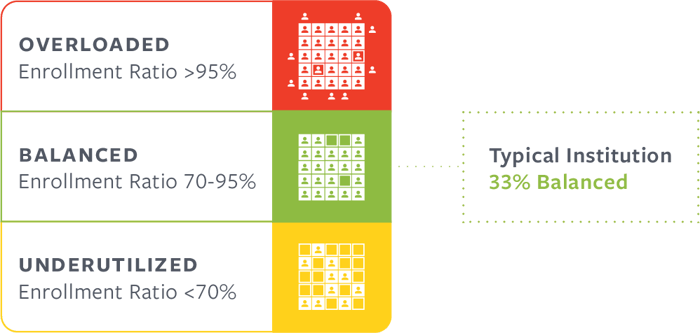
(Figure 5 – Balanced Courses)
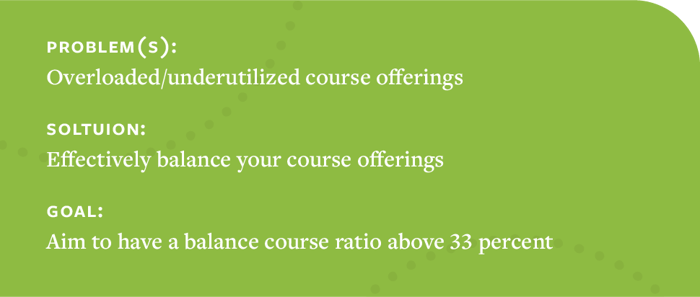
(Insert 3 – Balance Courses to Promote Student Success)
Thus far, we have discussed the importance of aligning course offerings with accessibility (enrollment ratio), within the constraints of the finite resources of faculty and facilities (balanced course ratio). Another crucial consideration in course scheduling is student availability. Focusing on when students are most likely to be on campus can impact the balanced and enrollment ratios. To help address this challenge, Ad Astra developed the prime ratio, which is the percentage of hours scheduled during peak usage hours, divided by the total scheduling hours.
Figure 6 below indicates peak classroom usage by day of the week (light blue) as a function of time. The largest bell distribution is generally indicative of a high percentage of course offerings that meet between the hours of 9 a.m. and 2 p.m. (primetime window) on a Tuesday and Thursday, generally the busiest days, in the scheduling week. The two lower curves may be indicative of scheduling on Monday and Wednesday that mirror one another, followed by Friday, which is generally the lightest of the five-day week.

(Figure 6 - Prime Ratio)
Much like television advertisers who seek to reach the broadest television audience possible, the prime ratio is an attempt to offer courses when students are most likely to be on campus (historically weekdays between 9 a.m. – 2 p.m.; but variable depending upon the demographic profile of the institution).
Generally, the prime ratio number should fall between 45 and 67 percent. A value of 40 percent means that 4 in 10 course offerings fall inside the primetime window. Approximately three-quarters of institutions have a value below 67 percent. Maintaining a balance inside and out of the primetime window is important for student success at your institution.
It is rarely a good idea to have only 40 percent of course offerings inside the primetime window. In so doing, you would be offering 60 percent of your courses at times where students are least likely to be on campus. Conversely, packing all courses into a small window may be infeasible due to faculty and facility availability, and it also can create challenges for students who are unable to attend campus during primetime hours.
Imagine your institution has a high percentage of ”traditional students,” those aged 18-24. Generally, traditional students prefer course availability between the hours of 9 a.m. – 2 p.m. However, if your institution offered 75 – 80 percent of course offerings during the primetime window, it may mean that “post-traditional students,” those aged 25 and older, who may be unable to take enough evening courses, may not have the ability to take a full schedule of courses outside of the primetime window.
Focusing on the primetime ratio can positively impact student retention. As Figure 8 below indicates, nationally, when including students at both two- and four-year institutions, the number of students returning to any institution for a second year is 61.7 percent. The first-year retention rate has improved less than three percentage points since 2009, despite considerable attention and resources dedicated to addressing this challenge.
(Figure 8 – First-Year Retention Rates, 2009 – 2017. Source: National Student Clearinghouse)
A less than three percentage point improvement over the better part of a decade is indicative of just how difficult it is for institutions to retain and graduate students on-time. While academic and socioeconomic disadvantages partially explain why more students do not graduate on-time, the impact of the course schedule also impacts student retention. Effectively managing the prime ratio is generally associated with about one-tenth of a percentage of improvement on student retention, net of the prior achievement of students attending the institution.
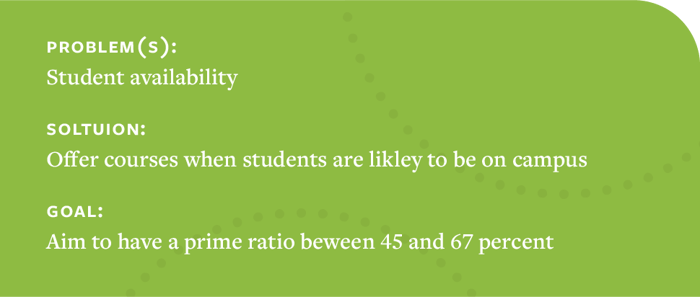
(Insert 4 – Offer Courses When Students are Likely to be On Campus)
4. Reduce Scheduling Inefficiencies to Graduate More Students Faster
Thus far, we have seen the importance of course access for students, balancing offerings for students and the institution, and providing seats when students are most likely to be available to take courses. A fourth crucial component is the ability to offer courses at times convenient for students, irrespective of primetime.
Figure 9 below figure represents a traditional meeting pattern between 9 a.m. – 11 a.m., with the dominant meeting pattern in light green on Tuesday and Thursday 9 a.m. – 10:20 a.m. Normally, on Monday, Wednesday, and Friday, the dominant meeting pattern should be 50 minutes beginning on each hour (9 a.m. – 9:50 a.m.; 10 a.m. – 10:50 a.m. light green). However, for this section, the course meets from 9:30 a.m. – 10:20 a.m. (orange). The result of this “off-grid” meeting pattern is waste created in the schedule as the classroom is not being used between 9 a.m. – 9:30 a.m. and 10:20 a.m. – 11 a.m. (red). When waste is created in the schedule, it means that facilities are not able to be optimized, and students have fewer options available during those hours. In the example below, students that take the off-grid course are not be able to take another course until 11 a.m. If the course were offered at 9 a.m., then they would be available to take a course at 10 a.m.
As institutions increase the amount of waste in their course schedule, they generally see between two-tenths to four-tenths of a percent decline in their graduation rates, net of the prior achievement of students. The reason is straightforward: if your students are unable to get the courses they need, when they need them, then they may have to delay their graduation by a semester or longer. Creating inefficient course schedules may be viewed as a penalty that institutions of higher education place on students, limiting their options across the semester.
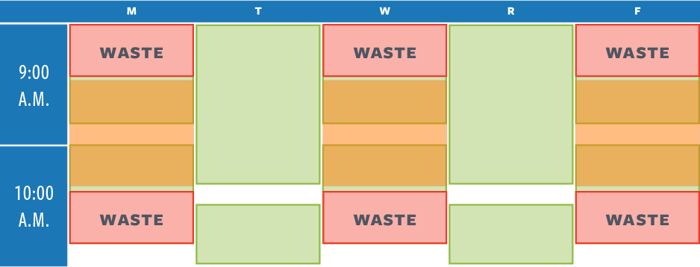
(Figure 9 – Off-Grid Scheduling and Waste)
When an institution reduces their off-grid waste in the schedule, their institution will tend to see increases in the enrollment ratio, as the same number of students can take more courses. Generally, there are also increases in classroom utilization in prime-time and in the total and average student credit hour production. Reducing off-grid waste improves time-to-completion and reduces instructional expenditures (because fewer classrooms are idle), all of which are generally positive outcomes for a college or university. About three-quarters of institutions run around 20 percent of their courses off the dominant meeting pattern, with the average institution wasting about 14 percent of their capacity (and students’ primetime registration options) through off-grid scheduling.
Given the importance of this metric, it makes sense to provide examples, both small and large, for how your institution can innovate to improve in this area. Starting small, a good first step would be to focus on the earliest hours of primetime (generally 8 a.m., 9 a.m., 10 a.m.) and work to ensure that the number of courses off-grid during those hours are below 10 percent. Starting on-grid earlier in the day can reduce the cascade of courses that are off-grid in that room throughout the remainder of the day.
A more advanced step that will likely have a greater impact at your institution would be to create a standardized meeting pattern policy for your institution. Recently, administrators at the University of Kentucky aimed to reduce waste in the course schedule by working with faculty, departmental chairs, and deans to pass a standardized meeting pattern policy through the faculty senate. The policy created a definition for standardized meeting patterns, specified standard meeting times, and prioritized high-enrolled (over low-enrolled), undergraduate (over graduate), required (over elective) and lower division (over upper division) section offerings.
Figure 10 below presents the percentage of courses on a standardized meeting pattern from Fall 2014 – Spring 2018 at the University of Kentucky. When the standardized meeting pattern policy passed in Fall 2015, administrators did not immediately make wholesale changes. Rather, administrators took time to explain the policy change and the future impact to faculty, department chairs, and deans. For courses that met off-grid, enrollment managers explained there might be a grace period, but those courses may not be approved in the indefinite future. The result of the policy change is that the percentage of courses on a standardized meeting pattern is over 60 percent for the first time on record.
(Figure 10 – Percentage of Courses on Standardized Meeting Pattern, University of Kentucky, 20014 – 2018)
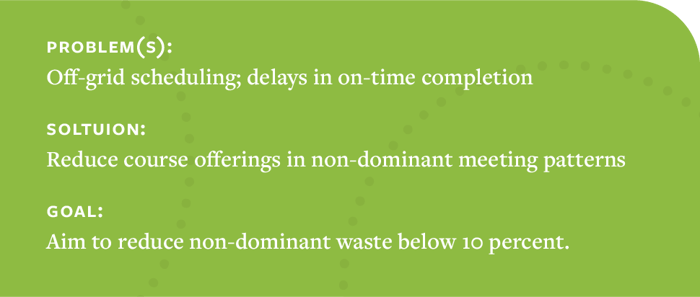
(Insert 5 – Reduce Off-Grid Scheduling to Graduate More Students, Faster)
Thus far, we have seen how focusing on a metric, or a series of metrics, can positively impact your institution. By benchmarking data, you can improve your enrollment ratio, retention, time-to-completion, and graduation rates to help college or university move forward. Key to this process is external benchmarking, a continuous improvement process designed to help your institution identify higher or lower data points among similar units from comparable colleges and universities. External benchmarking is the process of measuring similar operations, functions or activities outside the same unit or organization. External benchmarking is widely used within higher education. In fact, the most highly selective, the fastest growing, and the most improved colleges and universities all use external benchmarking to monitor their progress and remain accountable for their progress, or lack thereof.
Each of the metrices described above enrollment ratio, overloaded, balanced, underutilized, prime-ratio, non-dominant waste) are currently being benchmarked externally and have contributed to improving course access and resource allocation Ideally, your college or university can measure your progress over an extended period of time (generally, five years).
Recommended Resource: Higher Education Scheduling Index (HESI)
Figure 11 below presents all the key metrics discussed in this article and their benchmarked values within two standard deviations. A standard deviation is a statistical measure around the dispersion of data. In Figure 11, 95 percent of all the benchmarked observations for enrollment ratio fall between 54 and 98 percent, with an average enrollment ratio of 76 percent. In the example, a sample institution, highlighted in green, has an enrollment ratio of 89 percent.
(Figure 11 – Putting It Together: Benchmarks within Two Standard Deviations)
External benchmarking is a great activity for providing data-driven insights into where to improve, but equally important is understanding how to improve. Each year, Ad Astra works with more than 500 colleges and universities to help retain and graduate more students faster utilizing the course schedule. Through this process, Ad Astra has developed industry-leading expertise that empowers institutions to build upon their strengths and turn limitations into strengths.
A crucial first step toward strength-building is a complimentary course schedule evaluation, which allows your institution to benchmark course scheduling activities to comparable institutions. Through a course schedule evaluation, you can better understand how much higher or lower your institution is relative to comparable colleges and universities on the metrics described above.
Recommended Resource: Complimentary Course Schedule Evaluation
As part of the complimentary course schedule evaluation, Ad Astra will provide specific recommendations on where to start. Figure 12 below demonstrates the six key areas identified in this article (enrollment ratio, prime ratio, balanced, overloaded, underutilized, and off-grid waste) and offers consultative guidance on areas for improvement. In the example below, the sample institution has a very high percentage of overloaded courses (46 percent v. 22 percent, which is average), a high percentage of off-grid waste (22 percent v. 16 percent, which is average), and a relatively low percentage of balanced courses (30 percent v. 33 percent, which is average). By partnering with Ad Astra, your institution can receive consultative expertise on which areas to target first and tangible steps your institution can take to build institutional strength and improve outcomes. Other areas that can be triaged based upon resources and institutional priorities.
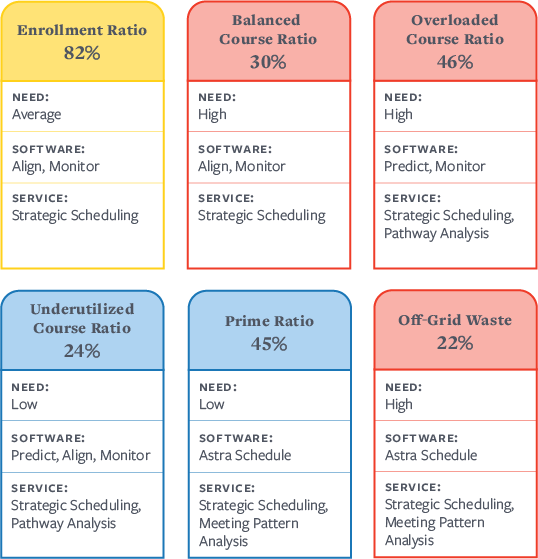
(Figure 12 – Sample Report of Opportunities for Strategic Engagement)
Integrating benchmarked metrics into a continuous improvement process can help your institution think more broadly about integrating course scheduling processes into ongoing institutional priorities. As you move forward on this journey, remember that the course schedule can be integrated into broader institutional initiatives such as accreditation, academic program review, access/diversity/inclusion, student success (retention, time-to-completion, graduation), college-career pathways (guided pathways/workforce development), and state policy frameworks (performance funding, system/state/gubernatorial initiatives).
Ad Astra offers a range of solutions designed to meet your unique needs, always with a focus on student and institutional success. To learn more, visit aais.com or download our most recent report on the topic here.
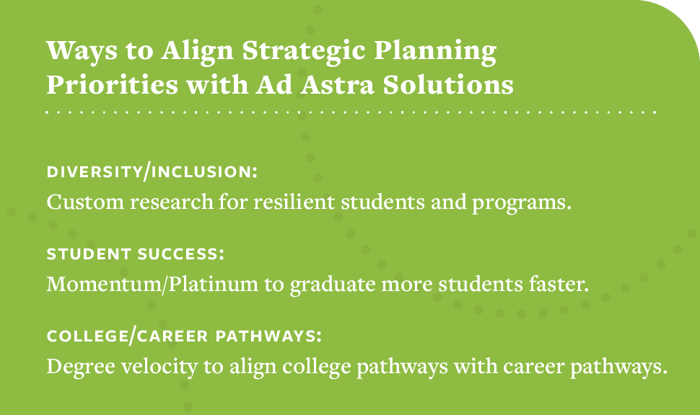
(Insert 6: Benchmark Change and Remain Accountable)

References
Ad Astra. 2018. Bending the Curve: How Colleges and Universities Can Rethink the Course
Schedule to Graduate More Students, Faster. Retrieved January 30, 2020 (https://www.aais.com/hesi-media-download-bending-the-curve-04568).
Bauer-Wolf, Jeremy. 2019. “Adult Learner Enrollment Keeps Sliding, New Data Shows.”
Education Dive. Retrieved January 30, 2020 (https://www.educationdive.com/news/adult-learner-enrollment-continues-to-contract/569285/).
Brown, Anna. 2018. “Most Americans Say Higher Ed is Heading in Wrong Direction, but
Partisans Disagree on Why.” Pew Research Center: Fact Tank. Retrieved January 30, 2020 (https://www.pewresearch.org/fact-tank/2018/07/26/most-americans-say-higher-ed-is-heading-in-wrong-direction-but-partisans-disagree-on-why/)
College Board. 2020. BigFuture. Retrieved January 30, 2020 (https://bigfuture.collegeboard.org/find-colleges/how-find-your-college-fit).
Flaherty, Colleen. 2018. “When Faculty Lines Pay for Themselves.” Inside Higher Ed.
Retrieved January 30, 2020 (https://www.insidehighered.com/news/2018/07/10/stephen-f-austin-optimizes-course-schedule-add-faculty-lines-paid-themselves).
Grawe, Nathan. 2018. Demographics and the Demand for Higher Education. Retrieved January
30, 2020 (https://jhupbooks.press.jhu.edu/title/demographics-and-demand-higher-education).
Hundrieser, Jim. 2012. Strategic Enrollment Planning: A Dynamic Collaboration. Retrieved
January 30, 2020 (https://www.ruffalonl.com/papers-research-higher-education-fundraising/strategic-enrollment-planning-a-dynamic-collaboration/).
National Association for College Admission Counseling. 2018. Guide to the College Admission
Process. Retrieved January 30, 2020 (https://www.nacacnet.org/globalassets/documents/publications/gcap2018final.pdf).
National Student Clearinghouse. 2019. “Current Term Enrollment Estimates: Fall 2019.”
National Student Clearinghouse. Retrieved January 30, 2020 (https://nscresearchcenter.org/wp-content/uploads/CTEE_Report_Fall_2019.pdf).
National Student Clearinghouse. 2019. “Persistence and Retention: 2019.”
National Student Clearinghouse. Retrieved January 30, 2020 (https://nscresearchcenter.org/snapshotreport35-first-year-persistence-and-retention/).
Nietzel, Michael. 2019. “College Enrollment Declines Again. It’s Down More than Two
Million Students in this Decade.” Forbes. Retrieved January 30, 2020 (https://www.forbes.com/sites/michaeltnietzel/2019/12/16/college-enrollment-declines-again-its-down-more-than-two-million-students-in-this-decade/#15273e103d95).
Redden, Elizabeth. 2018. “New International Enrollments Decline Again.” Inside Higher Ed.
Retrieved January 30, 2020 (https://www.insidehighered.com/news/2018/11/13/new-international-student-enrollments-continue-decline-us-universities).
Ruffalo Noel Levitz. 2019. 2019 National Student Satisfaction and Priorities Report. Retrieved
January 30, 2020 (https://learn.ruffalonl.com/rs/395-EOG-977/images/2019_National_Student_Satisfaction_Report_RNL-005.pdf).
Sanchez, Dwight. 2019. “Success Formula for Student Recruitment and Retention.” Diverse
Issues in Higher Education. Retrieved January 30, 2020 (https://diverseeducation.com/article/112742/).

Ad Astra is higher education’s solution partner in managing the academic enterprise. Partnering with more than 500 colleges, universities, and systems nationwide, Ad Astra helps improve stewardship of instructional resources, streamline student access to courses, and accelerate student completions.